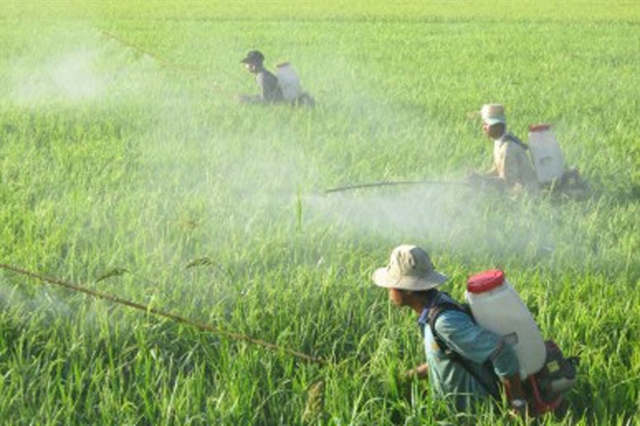 Environment
Environment

 |
| Hoàng Đức Cường, Deputy Director of the General Department of Meteorology and Hydrology at the Ministry of Natural Resources and Environment |
Hoàng Đức Cường, Deputy Director of the General Department of Meteorology and Hydrology at the Ministry of Natural Resources and Environment, talks to the Vietnam News Agency about the importance of establishing an early warning system associated with impact forecasting.
Can you explain what is impact forecasting and how it differs from impact-based forecasting in the field of hydrometeorology?
Impact-based forecasting focuses on potential impacts, rather than traditional weather information as the central information. The core question that impact-based forecasting seeks to answer is what impacts hydrometeorology is likely to have on various sectors such as agriculture, transport, tourism, and aquaculture.
For example, instead of answering the question of what the weather will be like tomorrow, an impact-based forecast will address how such weather will affect the economy, society, the environment, and people. An impact-based forecast bulletin is more comprehensive than a traditional forecast bulletin, including information on temperature threshold, rainfall threshold, water level threshold, and their impacts on different aspects of life.
Moreover, impact-based forecasting not only predicts heavy rainfall in a specific area but also indicates the possibility of flooding, landslides, and damage to transportation networks and buildings across the region.
Impact-based forecasting is particularly valuable for local governments and disaster risk managers, particularly in areas that are prone to natural disasters like storms, floods, and high tides. The Việt Nam Meteorological Agency, along with numerous other countries worldwide, has shown an interest in impact-based forecasting as a future development trend.
Impact forecasting involves predicting how a certain threshold of a natural disaster (e.g., 50mm of rain/24h, wind levels 6-7) will affect exposed objects, taking into account the vulnerability of those objects. For instance, instead of simply stating the amount of rainfall in millimeters, an impact forecast would predict how much flooding that amount of rain could cause, whether it would reach knee or ankle level. Similarly, instead of issuing a warning for wind level 10, an impact forecast would indicate the speed at which roofs could be damaged at level 4, small tree branches could fall at level 12, and power poles could break and fall at level 13 or above.
Impact forecasting is closely related to the disaster risk warning that the hydrometeorology industry is implementing in its forecast and warning bulletins.
Decision No. 18/2021/QD-TTg, issued on April 22, 2021, has amended and supplemented the regulations on forecasting, warning, and communication of natural disasters, as well as disaster risk levels.
When it comes to forecasting and early warning of natural disaster risks, this decision is significant as it merges two previous decisions. The first Prime Minister's Decision focuses on disaster forecasting and communication, while the second Prime Minister's Decision addresses disaster risk levels. Decision No. 18/2021/QD-TTg is the result of merging the two previous decisions, and this is the first new point that creates favorable conditions for decision-making units.
Decision 18 emphasises the importance of early warning, detailed warning, and increasing the reliability of bulletins. The newsletters are delivered to users more than an hour earlier than before. In addition, when issuing newsletters, forecasting and warning information is accompanied by a regulation on the level of disaster risk shown in the same bulletin. This is very convenient, logical, appropriate, and effective for the implementing unit, as well as the users who access and read the bulletin.
Decision 18 places special emphasis on early and detailed warning, as well as increasing the reliability of bulletins. Newsletters are now delivered to users more than an hour earlier than before.
In addition to this, Decision 18 has also made adjustments and supplements that are reflected in the thicker frequency of bulletins, which ensures that hydro-meteorological phenomena are updated continuously and regularly. Moreover, the regulation of disaster risk levels in Decision 18 has been carefully studied and adjusted based on the natural disaster patterns that have occurred in the past, providing levels that are more suited to reality. The level of detail of the disaster risk levels has been extended down to the district level and each small river basin.
These adjustments have contributed to earlier and more proactive prevention and control of natural disasters, especially when the level of disaster risk is forecasted in accordance with the reality of natural disasters. With an adequate and appropriate allocation of resources, proactive disaster response and prevention will become better and more effective.
How has the work of early forecasting, impact forecasting, and disaster risk warning in Việt Nam been done in the past, and what are the lessons learned from this work?
Since the beginning of 2020, the General Department of Meteorology and Hydrology has been adding impact warning information to the bulletin of storms and tropical depressions. As of now, all forecast and warning bulletins issued by the General Department of Meteorology and Hydrology must include information on the potential impacts on the environment and living conditions.
The impact forecasts released by the hydrometeorological agency have helped leaders and decision-makers better protect the public by providing recommendations on evacuations, school closures, and other protective measures to reduce damage to people and infrastructure. This has contributed to minimising economic losses.
Disaster risk prediction and impact forecasting are important tools for managers, policymakers, and other stakeholders involved in disaster risk management, emergency preparation, planning, and response actions.
Experience has shown that impact forecasting and disaster risk warnings are very effective for major natural disasters such as storms, floods, and large-scale heat waves. However, for types of natural disasters that occur gradually such as drought, saltwater intrusion, or small-scale, fast-occurring natural disasters affecting different areas, the mechanisms and methods of sharing information among ministries, branches, and localities need to be further improved.
The Hydrometeorological sector will continue to gather and enhance information about objects that may be affected by various types of natural disasters to provide realistic and appropriate reports. This is especially important for large and complex natural disasters that can severely impact people, properties, and communities during this year's storm and flood season.
In terms of initial experience, the Hydrometeorological sector acknowledges the importance of coordination between the Hydrometeorological Forecasting Agency and other ministries, branches, and localities. To accurately and timely forecast and warn of natural disasters, the meteorological agency must have a good understanding of the infrastructure, current status of agricultural production, and the living conditions of people in regions and localities. Without such coordination, the forecasts and warning reports of the hydrometeorological agency will be greatly limited.
To contribute to the implementation of "sustainable and adaptable to natural disasters," what programmes and plans does the General Department of Meteorology and Hydrology have?
Decision No. 10/2023/QD-TTg, issued on April 24, 2023, assigned the General Department of Meteorology and Hydrology many new tasks, such as assessing disaster risks and zoning, forecasting and assessing climate, hydrology, hydrogeology, wind, solar, wave, and hydroelectric potentials for directing, operating, exploiting, and producing non-renewable and renewable energy. The General Department is also streamlining its apparatus from 23 affiliated units to 19 units.
In order to successfully carry out the assigned tasks, the General Department of Meteorology and Hydrology is taking immediate steps to consolidate its organisation, particularly its hydrometeorological forecasting and warning units at both central and local levels. It is also assessing the impact of climate change on hydro-meteorological disasters in Việt Nam in order to incorporate this information into forecasting models and plans, with the aim of providing earlier, more detailed and more reliable information about such disasters.
Furthermore, the industry is promoting privatisation to create a favourable environment for businesses and individuals to participate in hydro-meteorological activities. The department is also making the most of the existing infrastructure and hydro-meteorological information within society, as well as strengthening the dissemination and education of laws related to hydrometeorology, to raise public awareness of the importance of utilising hydrometeorological forecasting and warning bulletins. VNS




